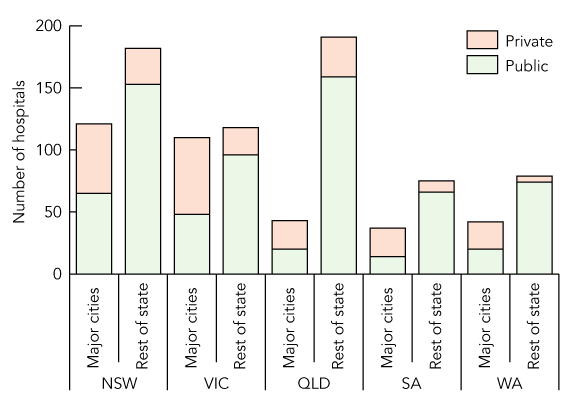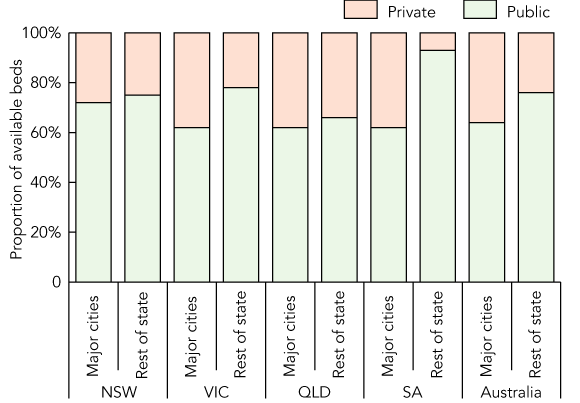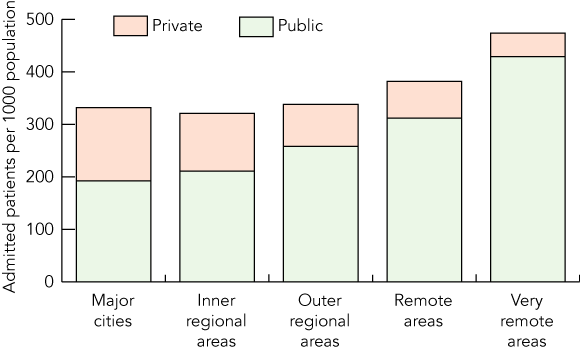The Australian Institute of Health and Welfare (AIHW) noted in a recent report that “[a] major problem in understanding the health of people in regional and remote areas is the limited availability, representativeness and quality of data”.1 Nevertheless, it is generally accepted that Australians living in rural and remote areas have lower health status than their counterparts in urban areas. The AIHW found, for instance, that “in regional areas during 1997–1999, death rates were, on average, 1.1 times those in major cities. In very remote areas, rates were 1.5 times as high as in major cities”.1 Various factors explain this disparity, including higher levels of health risk factors, the higher proportion of Indigenous Australians in rural areas, and less access to healthcare services.2
The lack of convenient, affordable and timely access to general practitioners, specialists and after-hours care is widely accepted as a major problem for Australians living in regional areas.3 Compounding this is the lower rate of bulk-billing and higher per-capita out-of-pocket health expenditure generally in regional Australia.3 Successive Australian federal governments have responded with a range of targeted healthcare programs for regional areas. Recent initiatives include rural medical scholarships, increased rural GP training places, retention payments, and higher Medicare rebates for GPs offering bulk-billing services in regional areas.4 Additionally, by supporting GPs and providing access to specialist and after-hours care, regional public hospitals and associated multipurpose services play an important role in addressing the inequitable distribution of healthcare resources. For example, as noted in a 1998 AIHW report, “people with chronic conditions such as diabetes and asthma may be hospitalised more frequently in rural and remote zones if they are required to travel long distances for follow-up treatment”.5
Limited published data exist comparing overall health financing levels in cities and regional Australia. Available studies suggest that, despite the lower health status and higher costs associated with the delivery of services in regional areas, they receive lower per-capita financing and expenditure on health than urban areas. For example, a 2001 report by the AIHW indicated that levels of per-capita health expenditure (total government and private) were lower in regional areas.6
While targeted programs can act as short-term boosters to regional health services, their effect is relatively insignificant compared with the regional importance of mainstream health financing policies and programs: Medicare, the Pharmaceutical Benefits Scheme, and private health insurance (PHI) rebates (discussed below).
Since 1996, an increasing proportion of federal government health expenditure has been directed into Australia’s healthcare system via PHI subsidies in the form of tax rebates. In so doing, the government aims to expand the level of PHI coverage, thereby encouraging the use of private hospital services and reducing pressure on public hospitals.7 An important part of these policy reforms is the non-means-tested 30% PHI rebate, which is estimated to cost the government $2.5 billion per year.8 As the rebate is uncapped, the public funds diverted to this program increase whenever membership or premiums rise. For instance, on 1 April 2003, the government authorised an average increase in PHI premiums of more than 7%, which is likely to cost taxpayers an extra $170 million per year in the rebate scheme.9 Moreover, clause 50 of the 1998–2003 Australian Health Care Agreement acts as a “clawback” provision, allowing the federal government to reduce public-hospital funding to the states and territories if PHI membership increases beyond a certain threshold.10
These reforms have meant that, since 1996, the federal government’s role in financing private hospitals has substantially increased, both in real terms and in comparison with funding increases to public hospitals. In 1996–97, federal and state governments provided 11% of the total funding for private hospitals in Australia.11 By 2002–03, primarily as a result of PHI rebates, the contribution of federal and state governments to private hospital funding had risen to 55%.11 Similarly, over the period 1996–97 to 2002–03, federal government funding of public hospitals grew at a real annual rate of 8%, compared with 64% for private facilities.11
We believe that, in the ongoing shift towards PHI as a means of healthcare financing, the federal government has failed to address the impact of this policy change on regional Australia. We conducted a study to examine the likely distributional effect of the reforms for regional inpatient funding and access to services.
In June 2003, we commissioned the Australian Bureau of Statistics (ABS) to supply previously unpublished data on the proportion of people with PHI living in or outside capital cities in each state.
The ABS analysis shows that PHI membership is lower outside capital cities — a statistically significant average of 6.7 percentage points Australia-wide (Box 1). The difference is greatest in Tasmania and least in Queensland (where a large proportion of the population resides in sizeable urban centres such as Townsville, the Sunshine Coast and Rockhampton). A previous survey by the ABS in 1998 found a similar regional disparity in PHI membership (an Australia-wide aggregate of 34.9% in capital cities and 28.0% in other areas).13
We estimate that the cost of the PHI rebate to regional Australia may exceed $100 million a year (Box 2).
There are two principal reasons for the urban–rural membership differences observed in our analysis; these relate to affordability and choice.13 First, income is one of the strongest predictors of PHI uptake, and average incomes are lower in regional than in urban areas.15 Multiple studies show that there is a clear income gradient to the uptake of PHI, with lower income groups less likely to have PHI.15 As a result, PHI as a mechanism for federal health funding disadvantages regional communities, compared with, for example, the distribution of funds on a per-capita basis.3
Second, a structural reason why PHI membership is less attractive to residents of regional areas is the limited availability of private facilities.16 The central reason to purchase PHI cover is to have affordable access to private hospital facilities. ABS and AIHW statistics on hospitals and bed numbers by location indicate that private facilities are concentrated in urban areas (Box 3).
Across Australia, only 16% of hospitals located outside major cities are private facilities.17,18 Of the available inpatient beds outside major cities, only 24% are located within private hospitals (Box 4). Not surprisingly, the bulk of patients requiring hospital admission in regional areas are treated within the public sector (Box 5).19 These findings highlight the fact that private hospital providers prefer (like banks and other commercial institutions) to concentrate facilities in areas of high population and service demand, often neglecting less profitable rural and remote areas with equal healthcare needs. These data suggest that PHI rebates funded through general taxation are unlikely to reduce the load on public hospitals in regional areas, as private facilities are often not available as substitutes. Additionally, as the Senate Select Committee on Medicare concluded in its 2003 report, regional Australians who are currently encouraged by the tax system to take up PHI despite limited opportunities for utilisation of private health services “effectively subsidise the PHI industry at the expense of their local public health services”.20
Finally, given that the level of PHI membership is higher in cities, it is likely that increased coverage as a result of reforms since 1997 has translated into disproportionately more private services being purchased from facilities located in cities than regional areas. The impact that this is likely to have on investment and location decisions of private hospitals since 1997 is to further increase the urban–rural disparity of public–private beds and services.
We have not attempted to consider the regional effects of all health financing systems in Australia. By focusing on PHI, we hope to highlight the point that, although targeted initiatives have a role in addressing regional inequities, it is far more important to ensure that mainstream policies and programs do not institutionally discriminate against disadvantaged groups. In recognition of this, initiatives are being developed in Australia and other countries to ensure that mainstream policy reforms take into account the impact on disadvantaged communities.
We have highlighted some of the structural failures of a PHI rebate scheme. PHI subsidies are a non-universal and indirect means of channelling public expenditures into the healthcare system. This approach gives governments only limited control over the regional and demographic distribution of funds, disadvantaging groups who are less likely to use or benefit from PHI, including those on low incomes and Indigenous Australians. While Medicare has limitations, its universality and the direct nature of hospital funding allow greater flexibility to promote equitable and needs-based distribution of funds.
1 Proportion of people covered by private health insurance (PHI) in 2001, by state and region*†
State‡ |
Capital city |
Rest of state |
Regional difference in PHI coverage (95% CI)§ |
||||||||||||
NSW |
50.4% |
43.3% |
7.1% (2.1%, 12.2%) |
||||||||||||
VIC |
49.6% |
41.0% |
8.6% (1.9%, 15.2%) |
||||||||||||
QLD |
45.4% |
45.0% |
0.4% (–5.3%, 6.1%) |
||||||||||||
SA |
50.5% |
41.7% |
8.8% (–0.4%, 18.0%) |
||||||||||||
WA |
53.9% |
48.5% |
5.4% (–2.3%, 13.1%) |
||||||||||||
TAS |
56.7% |
43.0% |
13.7% (4.3%, 23.0%) |
||||||||||||
National mean |
50.2% |
43.5% |
6.7% (4.3%, 9.0%) |
||||||||||||
* From unpublished Australian Bureau of Statistics (ABS) data derived from the National Health Survey.12 †People covered by PHI refers to anyone with hospital cover, including those with hospital cover only and those with hospital and ancillary cover. ‡Separate estimates for the Northern Territory and Australian Capital Territory were not available for this survey, but contribute to national estimates. §Confidence intervals are based on relative standard errors provided by the ABS. |
|||||||||||||||
2 Regional cost of the private health insurance (PHI) rebate
In 2001, 50.2% of people living in Australian capital cities were covered by PHI compared with 43.5% living outside capital cities. The 6.7 percentage-point gap between the two equates to 350 875 less people having PHI in regional areas.
Data on average PHI premiums are difficult to obtain because of the wide range of factors that affect pricing, such as the number of people covered by each policy, the existence of an “excess”, and the range of ancillary services covered.
Some data are available from the Private Health Insurance Administration Council (PHIAC). According to the PHIAC, the average level of contribution to PHI was $834.64 per member in 2001–02.14 Given that premiums rose by an average 7.4% in April 2003,9 the average premium per person covered would now be about $896.40.
If 350 875 people living outside capital cities were to take out PHI at an average cost of $896.40 per person covered, the additional cost to the federal government of its 30% PHI rebate would be $94.4 million per year (assuming the mix of hospital-only and hospital-plus-ancillary policies remained constant). This figure is likely to be an underestimate, as the average price of PHI is lowered by people who take out “ancillary only” health insurance policies, such as ambulance cover. Such policies are substantially cheaper than hospital cover and do not attract the government’s 30% PHI rebate. Thus, the cost to regional Australia of the government’s reliance on the PHI rebate to distribute resources is likely to exceed $100 million a year.
3 Number of public and private hospitals, by state and region, 2002–03*†

* Data for Tasmania, the Northern Territory and Australian Capital Territory were not provided. †Adapted from ABS and AIHW data.17,18
4 Proportion of available public and private hospital beds, by state and region, 2002–03*†

* Data for hospitals in Western Australia, Tasmania, the Northern Territory and Australian Capital Territory were not provided individually, but appear in the Australian aggregate. †Adapted from ABS and AIHW data.17,18
- Buddhima Lokuge1
- Thomas A Faunce2
- Richard Denniss3
- 1 Australian National University, Canberra, ACT.
- 2 Australia Institute, Canberra, ACT.
We wish to thank the Australia Institute for the purchase of original data used in this study from the Australian Bureau of Statistics.
None identified.
- 1. Australian Institute of Health and Welfare. Australia’s Health 2004. Canberra: AIHW, 2004. (AIHW Cat. No. AUS 44.)
- 2. Australian Institute of Health and Welfare. Rural, regional and remote health: a study on mortality. Canberra: AIHW, 2003: 13. Available at: www.aihw.gov.au/publications/index.cfm/title/9411 (accessed Feb 2005).(Rural Health Series, No. 2; AIHW Cat. No. PHE 45.)
- 3. National Rural Health Alliance. A more effective Medicare for country Australians. Canberra: NRHA, February 2003: 41. Available at: www.ruralhealth.org.au/nrhapublic/publicdocs/CD-ROM/data/papers/position_papers_2003.pdf (accessed Feb 2005). (NRHA Position Paper 3.)
- 4. Australian Department of Health and Ageing. Fact sheet 4 — A continuing commitment to rural, regional and remote Australians. 11 May 2004. Budget 2004–2005. Canberra, Australian Department of Health and Ageing, 2004. Available at: www.health.gov.au/internet/wcms/publishing.nsf/Content/health-budget2004-hbudget-hfact4.htm (accessed Dec 2004).
- 5. Australian Institute of Health and Welfare. Health in rural and remote Australia. Canberra: AIHW, 1998. Available at: www.aihw.gov.au/publications/index.cfm?type=detail&id=3420 (accessed Dec 2004).
- 6. Australian Institute of Health and Welfare. Expenditures on health services for Aboriginal and Torres Strait Islander people, 1998–99. Canberra: AIHW, 2001: 13 (Table 1.6). Available at: www.aihw.gov.au/publications/ihw/ehsatsip98-99/ehsatsip98-99-c01.pdf (accessed Feb 2005). (AIHW Cat. No. IHW-7.)
- 7. House of Representatives Hansard. Second reading speech by Dr Michael Wooldridge, Minister for Health and Aged Care, introducing the Private Health Insurance Incentives Bill 1998. Parliament of Australia, 12 November 1998. Available at: parlinfoweb.aph.gov.au/PIWeb/view_document.aspx?id=186505&table=hansardr (accessed Dec 2004).
- 8. Australian Department of Health and Ageing. Portfolio budget statements. Outcome 8: Choice through private health. Canberra, Australian Department of Health and Ageing, 2004. Available at: www.health.gov.au/internet/wcms/publishing.nsf/Content/health-budget2004-pdf-out8-cnt.htm/$FILE/out8.pdf (accessed Dec 2004).
- 9. Patterson K. Private health insurance premiums. Press release, 14 March 2003. Available at: www.health.gov.au/mediarel/yr2003/kp/kp1403.htm (accessed Dec 2004).
- 10. Parliamentary Library. Health Care (Appropriation) Amendment Bill 2002. Bills Digest No. 37 2002-03. Canberra: Commonwealth of Australia, 2002. Available at: www.aph.gov.au/library/pubs/bd/2002-03/03bd037.htm (accessed Dec 2004).
- 11. Australian Institute of Health and Welfare. Health expenditure Australia 2002–03. Appendix A. Canberra: AIHW, 2004. Available at: www.aihw.gov.au/publications/index.cfm/title/10043 (accessed Feb 2005). (Health and Welfare Expenditure Series No. 20; AIHW Cat. No. HWE-27.)
- 12. Australian Bureau of Statistics. National health survey: summary of results. Canberra: ABS, 2002. (ABS Cat. No. 4364.0.)
- 13. Australian Bureau of Statistics. Health insurance survey, Australia. Canberra: ABS, 1999: 10. (ABS Cat. No. 4335.0.)
- 14. Private Health Insurance Administration Council. Operations of the registered health benefits organisations. Annual report 2001–02. Canberra: PHIAC, 2002. Available at: www.phiac.gov.au/publications/ar_previous/82pa2002.pdf (accessed Dec 2004).
- 15. Schofield D, Fischer S, Percival R. Behind the decline: the changing composition of private health insurance in Australia, 1983–95. Discussion Paper No. 18. Canberra: National Centre for Social and Economic Modelling, University of Canberra, 1997. Available at: www.natsem.canberra.edu.au/publications/papers/dps/dp18/dp18.pdf (accessed Feb 2005).
- 16. National Rural Health Alliance. Public hospital funding: submission to the Senate Community Affairs References Committee, November 1999. Available at: www.ruralhealth.org.au/nrhapublic/publicdocs/CD-ROM/data/papers/03_sub_hospital.pdf (accessed Feb 2005).
- 17. Australian Bureau of Statistics. Private hospitals, Australia. 2002–03. Canberra: ABS, 2004. (ABS Cat. No. 4390.0.)
- 18. Australian Institute of Health and Welfare. Australian hospital statistics 2002–03. Canberra, AIHW, 2004. (Health Services Series No. 22; AIHW Cat. No. HSE-32.)
- 19. Australian Department of Health and Ageing. The state of our public hospitals, June 2004 report. Canberra: Australian Department of Health and Ageing, 2004: 24. Available at: www.health.gov.au/internet/wcms/publishing.nsf/Content/health-ahca-sooph-index.htm/$FILE/sooph2004.pdf (accessed Dec 2004).
- 20. Senate Select Committee on Medicare. Medicare — healthcare or welfare? Canberra: Commonwealth of Australia, October 2003: 148. Available at: www.aph.gov.au/Senate/committee/medicare_ctte/fairer_medicare/report/report.pdf (accessed Dec 2004).






Abstract
Since 1996, an increasing proportion of federal government expenditure has been directed into Australia’s healthcare system via private health insurance (PHI) subsidies, in preference to Medicare and the direct funding of public health services.
A central rationale for this policy shift is to increase the use of private hospital services and thereby reduce pressure on public inpatient facilities. However, the impact of this reform process on regional Australia has not been addressed.
An analysis of previously unpublished Australian Bureau of Statistics data shows that regional Australians have substantially lower levels of private health fund membership. As a result, regional areas appear to be receiving substantially less federal government health funding, compared with cities, than if these funds were allocated on a per-capita basis.
We postulate that the lower level of membership in regional areas is mainly due to the limited availability of private inpatient facilities, making PHI less attractive to rural Australians.
We conclude that PHI as a vehicle for mainstream federal health financing has potential structural failures that disadvantage regional Australians.